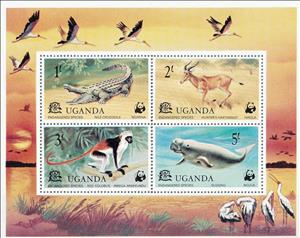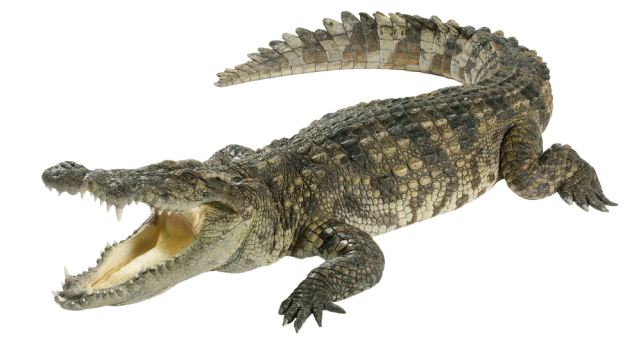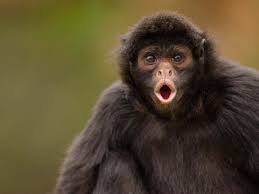Souvenir Sheet: Protected Wild Animals - MiNo. 167-70 (Uganda 1977)
Protected Wild Animals - MiNo. 167-70 (Uganda 1977)
26 September (Uganda ) within release Protected Wild Animals goes into circulation Souvenir Sheet Protected Wild Animals - MiNo. 167-70 face value 11.50 Ugandan shilling
| Souvenir Sheet Protected Wild Animals - MiNo. 167-70 in catalogues | |
|---|---|
| Michel: | Mi:UG BL8 |
Souvenir Sheet is horizontal format.
Also in the issue Protected Wild Animals:
- Souvenir Sheet - Protected Wild Animals - MiNo. 167-70 face value 11.50;
- Stamp - Pancake Tortoise (Malacochersus tornieri) face value 50;
- Stamp - Nile Crocodile (Crocodylus niloticus) face value 1;
- Stamp - Hartebeest (Alcelaphus buselaphus) face value 2;
- Stamp - Western Red Colobus (Colobus badius) face value 3;
- Stamp - Dugong (Dugong dugon) face value 5;
Souvenir Sheet Protected Wild Animals - MiNo. 167-70 it reflects the thematic directions:
Mammals are any vertebrates within the class Mammalia (/məˈmeɪli.ə/ from Latin mamma "breast"), a clade of endothermic amniotes distinguished from reptiles (including birds) by the possession of a neocortex (a region of the brain), hair, three middle ear bones and mammary glands. All female mammals nurse their young with milk, secreted from the mammary glands. Mammals include the largest animals on the planet, the great whales. The basic body type is a terrestrial quadruped, but some mammals are adapted for life at sea, in the air, in trees, underground or on two legs. The largest group of mammals, the placentals, have a placenta, which enables the feeding of the fetus during gestation. Mammals range in size from the 30–40 mm (1.2–1.6 in) bumblebee bat to the 30-meter (98 ft) blue whale. With the exception of the five species of monotreme (egg-laying mammals), all modern mammals give birth to live young. Most mammals, including the six most species-rich orders, belong to the placental group. The largest orders are the rodents, bats and Soricomorpha (shrews and allies). The next three biggest orders, depending on the biological classification scheme used, are the Primates (apes and monkeys), the Cetartiodactyla (whales and even-toed ungulates), and the Carnivora (cats, dogs, seals, and allies).
Marine mammals are mammals that rely on marine (saltwater) ecosystems for their existence. They include animals such as cetaceans (whales, dolphins and porpoises), pinnipeds (seals, sea lions and walruses), sirenians (manatees and dugongs), sea otters and polar bears. They are an informal group, unified only by their reliance on marine environments for feeding and survival.
The term antelope refers to numerous extant or recently extinct species of the ruminant artiodactyl family Bovidae that are indigenous to most of Africa, India, the Middle East, Central Asia, and a small area of Eastern Europe. Antelopes do not form a monophyletic group, as some antelopes are more closely related to other bovid groups, like bovines, goats, and sheep, than to other antelopes.
A better definition, also known as the "true antelopes", includes only the genera Gazella, Nanger, Eudorcas, and Antilope. One North American mammal, the pronghorn or "pronghorn antelope", is colloquially referred to as the "American antelope", despite the fact that it belongs to a completely different family (Antilocapridae) than the true Old-World antelopes; pronghorn are the sole extant member of an extinct prehistoric lineage that once included many unique species.
Crocodiles (family Crocodylidae) or true crocodiles are large semiaquatic reptiles that live throughout the tropics in Africa, Asia, the Americas and Australia. The term crocodile is sometimes used even more loosely to include all extant members of the order Crocodilia, which includes the alligators and caimans (family Alligatoridae), the gharial and false gharial (family Gavialidae) among other extinct taxa.
Monkey is a common name that may refer to most mammals of the infraorder Simiiformes, also known as simians. Traditionally, all animals in the group now known as simians are counted as monkeys except the apes. Thus monkeys, in that sense, constitute an incomplete paraphyletic grouping; however, in the broader sense based on cladistics, apes (Hominoidea) are also included, making the terms monkeys and simians synonyms in regard to their scope.
Animals are multicellular, eukaryotic organisms of the kingdom Animalia (also called Metazoa). All animals are motile, meaning they can move spontaneously and independently, at some point in their lives. Their body plan eventually becomes fixed as they develop, although some undergo a process of metamorphosis later on in their lives. All animals are heterotrophs: they must ingest other organisms or their products for sustenance.






